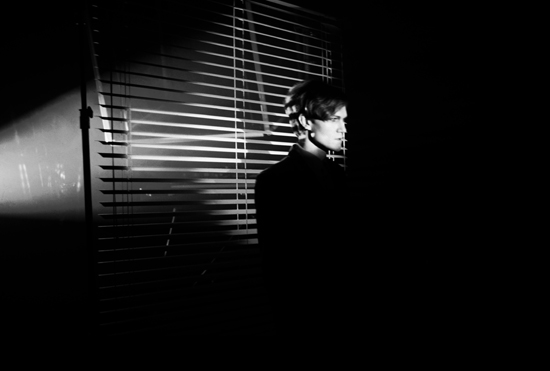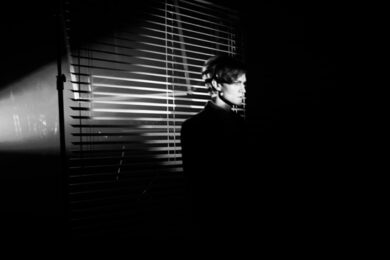John Foxx is nothing if not subtle. His alter ego is the Quiet Man — a faceless person in a grey suit who walks through cities and green landscapes, observing, unnoticed. In a series of writings and films composed over a 30-year period, the Quiet Man has been played by a host of actors and walked through countless miles and endless frames of film. That particular suit was one of the highlights of a blink-and-you’d-miss-it exhibition, DNA, which showcased several films, visual and sound pieces by artists who were inspired by Foxx’s work. There are a lot of them too, as Foxx’s career stretches through sleek synth dystopias to gliding ambient work, spanning video and graphic design, collaborating with everyone from other musicians to architects. If you want inspiration, there’s a lot to choose from.
Foxx’s influence is like one of those plants that builds complex root networks underground and suddenly sprouts in a lot of places at once. As for the man himself, he’s been busy lately. Over the last year or so, he’s released an album of spoken-word Quiet Man stories with an accompanying book, as well as albums of collaborations with Robin Guthrie (the gorgeous, swoony Mirrorball) and with Steves Jansen and D’Agostino. This autumn sees the video release of the films included in the DNA exhibition, and an album, Impossible, with Louis Gordon.
As the exhibition closed, I got to talk with Foxx about his music and his film projects, future technologies and ghosts of cities. It’s not as pretentious as it sounds.
What made you decide to publish The Quiet Man as a book and spoken stories, instead of as films?
John Foxx: It was started as a book, but it became some other things — I was never confident about my writing, and so I also found another use for it, because it gave me a lot of ideas for songs. And I used it like that for years. I would write an episode or two, and then I would have a title for a song, or something like that, and then that became its use. So I thought, maybe that’s what it’s for. And then digital film happened, and I realized I could put together all the bits of Super 8 I’d been shooting over the years to make some digital movies. And I got very interested in the way new technologies allow you to transpose stuff from older technologies, and make it practical for the first time. ‘Cause when I shot the Super 8, it wasn’t really possible to do anything with it. I thought of transferring it to 35 mm, but you know, it’s very expensive. Even that’s not very practical really. But now digital technology’s in, and I can do all that a lot easier, and make it projectable. Thank god all this has been going on long enough to bridge about three or four different technological changes.
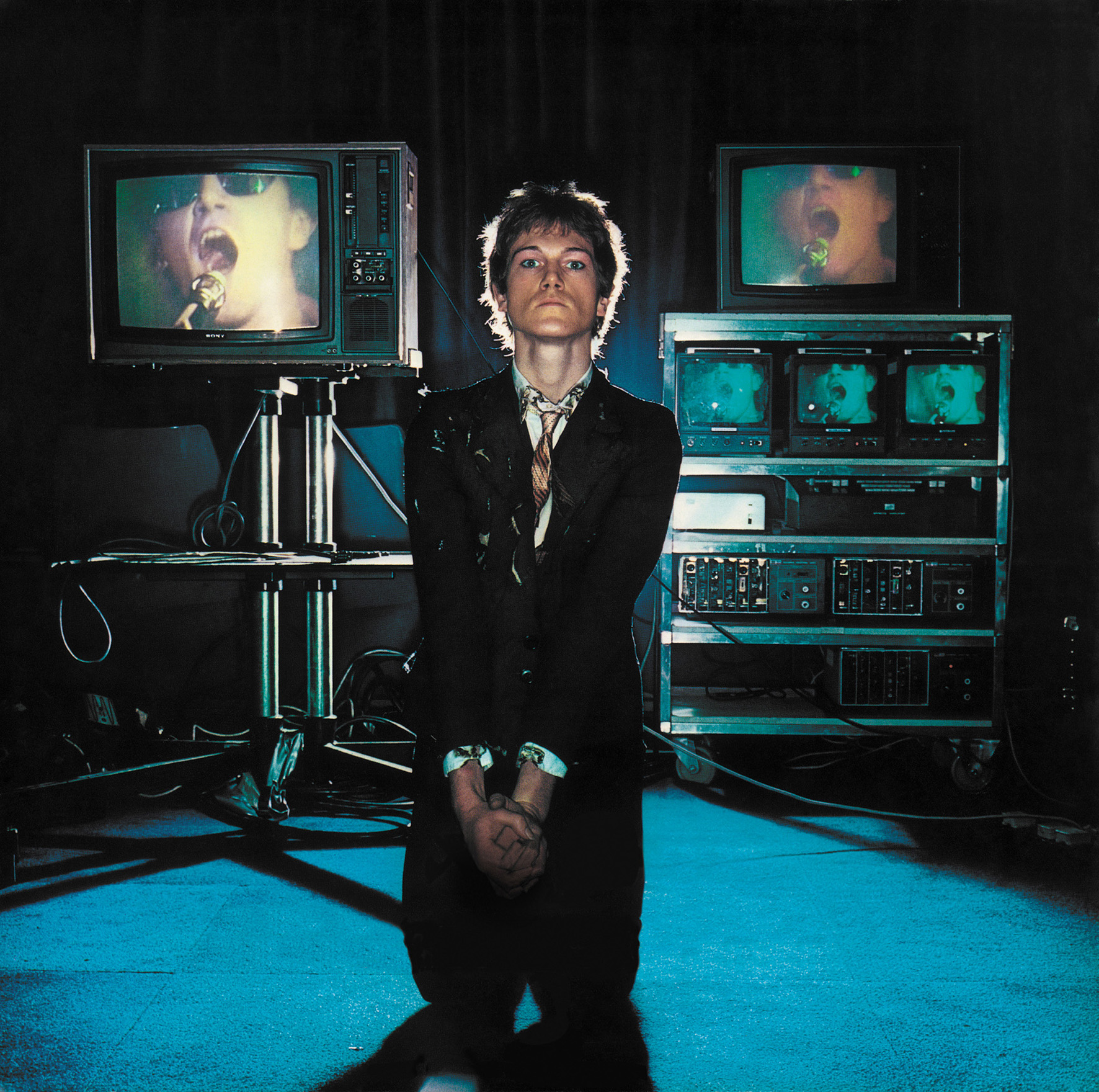
You have a lot of collaborators that you’ve worked with on this series. You were saying there were other people that you’ve worked with who would wear the grey suit and walk around, and participate in it, and they’d have to have a similar kind of awareness of history or the grammar of film language to be able to do that effectively. So how do you find collaborators that have a similar vocabulary and mindset to you?
JF: Well, it was just my generation, I think. A lot of people were making music and were always interested in film, and just understood basically what I was trying to do. And thought it was interesting, and were curious to see what they’d look like on film, even though you’d never see their face, it was always this sort of figure. So there’s a whole series of people who are the Quiet Man. And I kind of like that; I like him as a figure, he can even change, you know, he might even change physically sometimes. Because in the writing, he becomes younger and older in various episodes, and travels between those states. And I think that’s very much like the way you remember things, you know: I remember my youth quite a lot, and childhood, so there’s a very young man, there’s sort of a young man, and there’s an older man, all different men in one figure. And that’s what I am. So I sort of refer to that. And so, to answer your question, yeah, you need sympathetic friends to do it.
Your work also features abandoned hotel rooms, buildings . . . it’s almost as if there’s a flipside, you have all of these buildings where everything is pure and serene, and then you have these ruins where everything is overgrown, everyone in the world is gone, there are fallow, wild places . . . do you see these as counterbalances to each other?
JF: I think they are, in a way, although one’s alive, and the other one’s passing. I think part of it is an old thing to do with me, and growing up when I did, which is just after the war, when there were lots of layers of ruins around. One of them was from the war, there were lots of bomb sites in Liverpool and Manchester, and everywhere you went — I used to travel by bus a lot when I was a kid, and I used to look out of these windows and see these gaps in the buildings, and overgrown places where we used to play, that had been bomb sites. The war seemed a long time before that, it seemed like ancient history to us, but of course it was only five years, really, or maybe a little bit longer, but not much — ten years at most.
I remember seeing paperwork with brambles growing out of it, because [a factory’s office] had decayed so much that it was able to support another form of life
And then the other layers of ruins, where I grew up in the north-west, when factories were closing down, and we used to play in the factory buildings, enormous buildings, and they became overgrown, and I used to walk into the offices and see all the paperwork. I remember seeing paperwork with brambles growing out of it, because they’d decayed so much that it was able to support another form of life. I remember thinking how, all the accounts were written by hand, and I remember thinking how interesting it was that someone would spend their life on this stuff, and now it is just fodder for a blackberry bush growing out of it. So all those ruins were very important to me growing up. And I liked it, I liked the melancholy of it, the change of it and so on. And that means regrowth, you know, that there’s another world on its way, that was the world of the sixties and everything that promised, which didn’t quite come to pass, but it was a great vision of the future. So it’s that moment that travelled with me as I grew up, and I see resonances all over. Now being in London, I’m always wondering what London would look like overgrown or reborn, equally. What would happen if you replanned it, the whole place, or planned it as a different city? Made it into a partly overgrown place. I love this talk of greening cities, and so on — I’d love to grow things over all the buildings, and make zones that are like that. So I think all those things will continue, all those themes will continue.
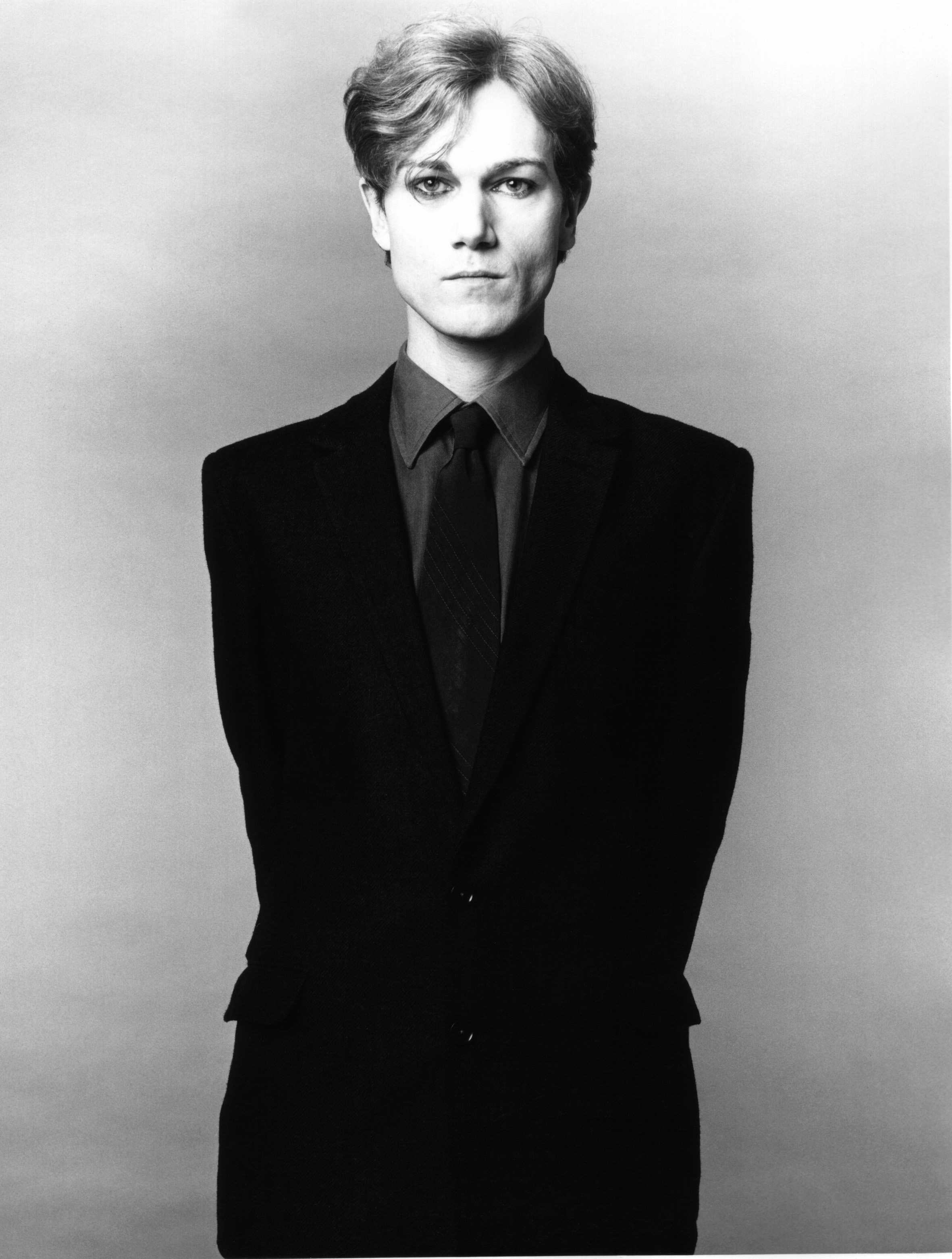
Do you feel some kinship with writers who deal with this in their work? I’m thinking of people like Iain Sinclair . . .
JF: Yeah, oh, yeah, very much, it was great to find his work, because that clarified things. People had said that I should read Guy Debord, and that was the first writing about psychogeography, and about walking through cities . . . but there were surrealist tracts before that, about random encounters and so on, that I used to like when I was an art student. And I always liked walking through the city because of things that happened. I always did that, even when I was very young, and I realized I enjoyed it, but I didn’t really have a context for it, or any name for it, it was just wandering about. Mooching about, I used to call it, when I was a kid. And I still say that to my kids now, come on, let’s go for a mooch, and we just wander around, and look at things, and talk about stuff. And it’s things like that, it’s a human sort of grazing, you go to a city and you wander about and invite things to happen around you, or just observe the dramas that go on and just feel them. You get a feel of the place, how it operates, the rhythms, it’s a very oceanic sort of environment, really, in an odd way. And then I read bits of Guy Debord, and so on, and that corresponded exactly with that, and then the English one that really meant something was Iain Sinclair. And he applied it to London, and got the mystery of London right, I think. And he led the territory and ground for a lot of other new writers. Every writer, from [Peter] Ackroyd and so on, has taken that as a premise, even people like Jeanette Winterson and some others, have very strongly taken that area and used it as a basis for their fiction; or faction, you know, things that are based on fact. And that all goes back to EL Doctorow, in America, with Ragtime; sections of that I really like. I think he was the first writer to do that, independent of Sinclair, but everyone else has read Sinclair, so . . . yeah, Sinclair’s a very important English writer for this time. Along with Ballard. I think those two writers are very important.
I’d like to ask about your Battersea project, because that’s so loaded and iconic, especially with Pink Floyd . . . But Battersea as a ruin, and your projection: can you explain this project, what and when you plan to do with it?
JF: It was partly to do with that idea of London overgrown, and the original idea was to project Cathedral Oceans onto it.
Oceanic from Cathedral Oceans III built by KARBORN
Cathedral Oceans is a long project, and that was about the same sorts of themes, but from a bit of a different angle. And we just thought that, well, first of all the images are meant to be projected as big as possible. I wanted it to be huge, because they are sort of monumental images. And so we thought the ideal place would be the biggest wall in London, which would be Battersea. But also Battersea’s got lots of other resonances: it is a ruin, it’s been there for a long time, no one knows what to do with it, it’s monumental, it’s right in the centre of London, and there’s a long, long history of people attempting to do things with it, and not succeeding. It’s a kind of modern folly, and it’s a very powerful piece of imagery that’s unconsciously embedded in Londoners’ minds, cause we don’t think about it — it’s always there. I remember when I walked round it for the first time, many years ago, when I had a studio in the early 80s, someone even then was trying to get people together to buy the place — which was for sale for about five quid, on condition that something was done with it. But everyone realised that it was so enormous . . . we went down there as kind of a posse of people, thinking that maybe purchasing this place and doing something with it, and just realising how difficult that would be, because it’s just so enormous! And I lost interest in it. I mean I would have loved to have done it, but I realised that I couldn’t.
Battersea Power Station, in Londoners’ minds, is almost like the pyramids, or the sphinx
And so there’s a long history of that, and it’s almost like, in Londoners’ minds, it’s like the pyramids, or the sphinx, something like that. It’s a remnant of another age that has, oddly, an application to this age, and no one can figure out how to incorporate it into this city. And also it’s near the river, which is great, the location’s wonderful, so if you did project things onto it, a lot of people would see it, so it would make something magical at night, because it would be illuminated. Because of the nature of things I want to project on it, you could shift the shape of Battersea, of the building and the power station quite a lot, and then project things onto it. And that’s one of the great things about projection, that you can change the shape of things. So that would be part of the project, really, the projections would make it into different environments, so it could be a building, or a cliff face or a monumental statue or an overgrown ruin, or another Bauhaus-type building . . . you could show off some of the ghosts of the future, and I think it could be very exciting. And you could play music as well, we were thinking — there was a scheme of working with Resonance FM to have that broadcast at the same time; people could have headsets and go down the river on boats, and look at it with the soundtrack. So with all these ideas that we’re working on, they take a lot of time to fit together, we have to get several sets of sponsors and so on. But it’s taking shape, we will do something with it, I hope in about a year. I’d say it took a year longer than I thought to get the thing started, but we’ve got it started now, we’ve got the thing in motion, several people want to join in with it, we’re just looking to finalise.
It reminds me a little bit of David Byrne’s project at The Roundhouse of playing the inside of a building.
JF: Yeah, well that’s on the cards as well, because a friend of ours does that. He took part recently in a tuned buildings festival in Berlin, where everyone made music from the buildings in various ways, from miking them up so their daily creaking, as they expanded and contracted, was made into sound, and then manipulated, to using vibration from traffic, from outside to into the walls to operate musical instruments and so on. So there’s a whole gamut of ways of making music from buildings, from temperature control . . . so I’d need a sort of draught sensor, to sense the way the air was moving and make music with that. So there are lots of ways of doing that, and so we were thinking about doing an aspect of that, or a part of that project in that way, to supply some of the soundtrack. There are all these possibilities with that, and with other buildings as well — I think what we wanted to do was alter London a bit, that was the idea. And you can do that in a very innocent way; through projection at night you can change the shape of things quite dramatically. And that’s very exciting to me, again that’s new technology — five years ago, you couldn’t have easily done it, because digital technology wasn’t able to project to that power and that definition, but now you can do it. So I think you’ll see from now on a lot more works that are projection-based. And I intend to do it as soon as I can, because I’m quite aware of the possibilities of it, and I think that they’re very exciting.
One of the films in the DNA show, the animation based on your Metamatic album, used a lot of retrofuturism to show technological change, from the noises to the way the lyrics were typeset. And I wonder what your opinion of that is?
Clicktrack by Jonathan Barnbrook
JF: Well, that retrofuture thing is interesting because there’s a trail of futures that are left behind in science fiction movies and things like that, and some of them are very influential. But the interesting thing is how some of them come back, things like telepathy and mobile phones, sort of recur, so you can find that they get dismissed as science fiction — they’re not practical — and then the real thing comes along, in a slightly different form but sometimes more powerful. And that’s interesting, because there are all these sort of little feedback loops going on, constantly, and also that idea of possible futures is interesting because of the look of the architecture, the look of cities, and the idea of cities changes, from Metropolis to Blade Runner — where you get the funky version of, the torn up version or the punk version of Metropolis — so there are several versions of cities that are in fiction. And mythlands have always interested me, because there seems to be some sort of ratio of how inaccessible they are that makes them into mythlands. If something exists, like the wild west, or outer space, we know they’re there, but we can’t get to them. We are then able to imagine, and transpose all kinds of desires into them, to make them really useful as mythlands for us, for our purposes. I think the wild west is a good example, and how redundant that became when people could go there, and found out there weren’t any cowboys with six-shooters or any of that stuff that may have happened once, in a different form, a long time ago, but it certainly wasn’t in operation by the times the films were really made, in the 1950s (although there were things that were similar, but they weren’t real). And then that fed back into all kinds of forms that determined how people dressed for tourists and so on, in those places. So there’s that sort of feedback loop and mythology that was going on, back and forth, and then being destroyed because people could go there. Outer space is a different matter, because it’s much bigger, and the myths of it are slightly different, but it’s essentially the same — it’s somewhere you can’t get to. It’s like the ocean used to be, in Homer’s time. Because people didn’t know what happened at the horizon, whether things just fell off or whether things continued. You could have maps saying ‘here be monsters’ and not know any better. And there may be monsters, we don’t know. And it’s that inaccessibility. So there’s all that expectation — and there’s that whole hauntology thing too. The way I understood it is as something Mark Fisher used to write about on that website . . .
K-punk?
JF: K-punk, which I think is a great site. I like his writing, I admire his writing, because he’s so prolific and he’s really interesting. He was writing about hauntology from literary ideas and images that come back and haunt . . . come back as ghosts, modern ghosts, which is something that’s always interested me. There’s all that side of it too, it leads to media, mediums as a repository of ghosts, you know, you’ve got Marilyn Monroe, who we can see, even though she’s dead of course — you can see her ghost, she’s just made of light and her dress blows up on the grating . . .
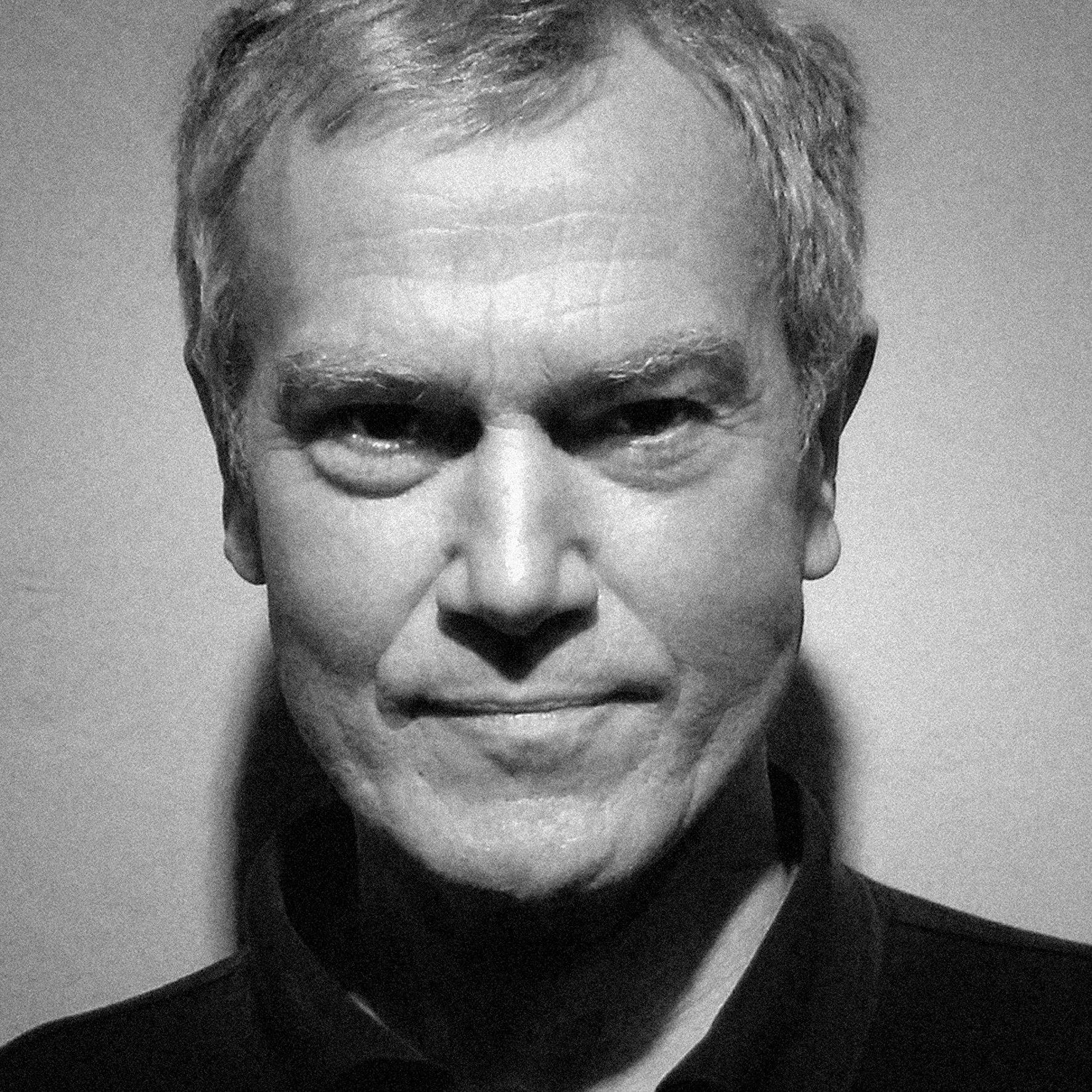
This is like Ballard’s recreation of celebrity car crashes, as a way to reconnect with these holy ghosts of a media age . . .
JF: Yeah, it is, because it’s a part of our lives, these images . . . and I don’t think we really understand what media is yet. We’ve had modern media, movies and photography, for a hundred and fifty years altogether; but we don’t know what it is yet. And so if I begin to talk about ghosts, people will think that I’m talking about something supernatural, but I’m not, I’m trying to find a way to describe what that kind of media does.
Like echoes . . . I keep thinking about that Metamatic film. It ends with the end titles repeated from several Hollywood films of the 40s and 50s, and you can recognize them as products of a certain time, but you can’t see them in the same context they were designed in — you can’t go back in time, that’s the final frontier.
JF: I mean the closest thing to time travel is watching movies. Isn’t it? And that’s the strange thing, psychologically, about movies, no other animal will sit there for two hours in the dark watching things go across the screen. We’re the only animal that can possibly do that. And we do that because we make a lot of very fast associations, and our memories work in a certain way, so that people are good at that kind of art can trigger lots of these emotional responses in people very quickly, through light and sound. So that relies on all kinds of things, like language, and memory, and associations and so on, and so we can make up stories of our own to accompany the stories that we see and we can walk into the film, to get where we are."
John Foxx performs The Quiet Man and his multi-media project Tiny Colour Movies at The Venue, Leeds College of Music on October 29 (Box office – 0113 222 3434)
More details at TheQuietMan.co.uk and Metamatic.com.

